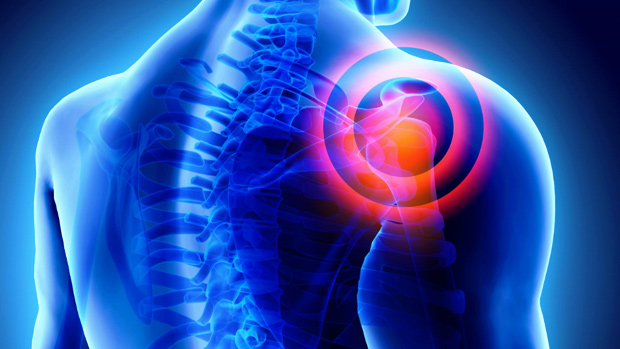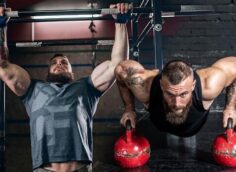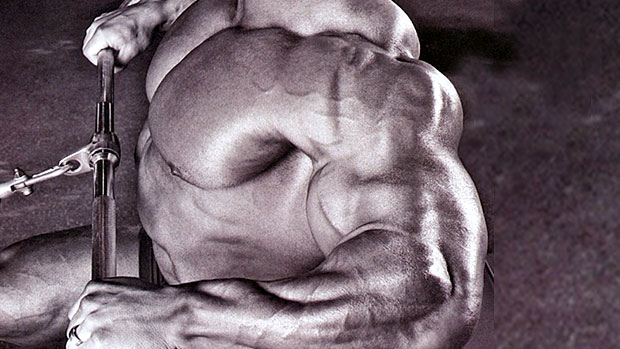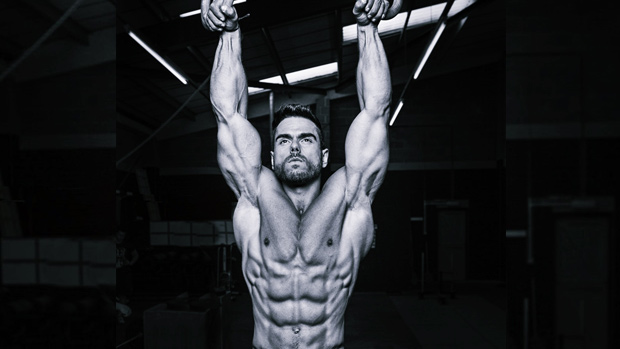Call it a law of weightlifting: no matter how careful you are, at some point you're gonna get hurt. Now you probably won't decapitate yourself with a barbell or tear a pec or even rupture your spleen—the weightlifter's injuries are rarely that cool or sudden.
Nope, you'll probably just end up with a bum shoulder, a pinched elbow, a bad back, or creaky knees, all the result of years of faulty movement patterns, poor training habits, or just general wear and tear. And while these injuries are always frustrating, they're often manageable.
Because it's hard to build a good-looking body when you're hurt, I talked with Eric Cressey and Mike Robertson about how these body parts probably got jacked up in the first place, and asked them for simple strategies to get you healthy.
Look here, Nancy. You can always train.
"But my shoulder hurts!"
Tough.
"I've trained guys in back braces and on crutches," says Cressey. "We even trained a guy with poison ivy. You have no excuse to not get in the gym."
So there.
Why it's (probably) jacked up:
"A lot of guys have very tight pecs and lats," says Cressey. "The tight pecs pull the humerus into too much internal rotation and pull the scapulae into anterior tilt. This makes it hard for your rotator cuff to "breathe" as you protract, elevate, or do almost anything."
In short, that's why you have pain when you bench press or overhead press.
And it's not just tightness.
"What's the first thing you do when you walk into the gym when you're 14 or 15?" asks Robertson. "You bench."
This propensity to always do more pressing than pulling exacerbates the problem by shortening your pecs even more.
In the gym
The first line of defense is aggressive soft tissue work on the pecs and lats to re-establish length and "open up" more range of motion. Follow that up with a few mobility exercises like the side-lying extension and some static stretches like the ones here and you'll be good to go.
You also need to skew the ratio of pulling to pushing exercises. And we're not talking a one to one ratio, either. "One pulling exercise to counteract one pushing exercise only makes sense if you're already in perfect alignment," says Robertson.
That's why he recommends a two to one or even three to one ratio.
So, an upper body day may look like this:
- Vertical Pull (Pull-up)
- Horizontal Pull (Barbell Row)
- Face Pull
- Pressing Exercise (Preferably done with dumbbells)
This concentrated upper back work will strengthen the muscles that will pull your body back into alignment.
According to Robertson, it's also a good idea to throw in some concentrated rotator cuff work like external rotations, and isolation exercises like wall slides and prone I's, T's, and Y's to help strengthen the stabilizer muscles.
At home
If you're constantly in a flexed posture (like sitting at a computer) you're just reinforcing bad habits. "After about 20 minutes of being in the same position, "creep" sets in and your body will start to get stuck there," says Cressey.
That's why the best posture is the one that's constantly changing.
"Get up every 20 minutes, get a drink of water, pace around, do whatever it takes to not sit down for hours on end," says Robertson.
Also, the next time you're watching TV, grab your foam roller and do some thoracic extensions. This will help add more mobility to your thoracic spine, which will "open up" your shoulder even more.

Why it's (probably) jacked up:
"When you start to get medial elbow pain—pain on the inside of your elbow—it's rarely a result of something you did wrong," says Cressey.
So a hurt elbow is normally just a result of consistent training. (Which kinda sucks.)
"You have a small bony area with a bunch of tendons and ligaments coming together in the same spot," says Cressey. "They create friction over one another and get more dense, fibrotic and nasty. Over time they lose length and quality, and every time you grip something they shorten up even more which leads to pain."
In the gym
You can use your thumb or a golf ball to try and work on the tissue of your forearms, but you gotta be careful since the ulnar nerve runs right through it. "Trust me," says Cressey. "You don't want to hit that."
That's why he and Robertson both recommend hiring a professional to perform Graston or ART on your arm. Pony up the dough and don't try to take matters into your own hands.
And while there aren't really any concentrated exercises you can do to "fix" your elbow, there are some ways to work around it.
"You can use weightlifting straps on a lot of exercises to take the pressure off," suggests Cressey.
You can also experiment with crossover reverse flys and straight-arm pulldowns instead of rows. If you want to row, however, you can try using a pronated thumb-less grip, which will help take more pressure off the elbow.
Switching to more push-up variations for your pressing exercises will help, too.
And if you still want to use barbells for benching or overhead pressing, Robertson wants you to keep your wrists in perfect alignment. "A lot of guys will 'roll' their wrists back at the bottom of the exercise, which will definitely put more stress on the elbow," he says. "It's a general weakness, but a lot of guys can fix it by simple becoming aware that they're doing it."
Why it's (probably) jacked up:
When it comes to bad backs, there are two main culprits for guys who work out: misuse and overuse.
Misuse is making your lower back do things it wasn't designed to do like rotating during exercise. "If your hips are stiff and can't move, your body will use the path of least resistance and get movement from somewhere," says Robertson.
And overuse is like doing deadlifts every day for a week—you're just hitting the muscles way too often.
But Robertson likes to sum it up even more simply than that:
"Combine horrible hip mobility, a weak core, and inactive glutes and hamstrings and you've got a bad back," says Robertson.
In the gym
If you haven't figured it out yet, the first thing you're gonna do is improve the soft tissue quality of your lower body, namely your glutes and hip external rotators. Cressey also recommends getting ART and massage on your lumbar erectors (they're hard to hit directly with a foam roller).
Next up are long-duration stretches for your hip flexors. Robertson recommends starting with three-minute static hip flexor stretches twice per day. Add a minute every other day or so till you work up to a full twenty-minute stretch. (When Robertson suggested this, by the way, I reminded him that that was 80 total minutes of extra stretching per day. Know what he told me? "Tough. Just do it." Nice guy.)
"You need to get to the point where you're physically tearing the muscle down," says Robertson. "It signals to the body that it needs more length."
After you've done your soft tissue work, it's time to activate the right muscles. Robertson recommends doing the following exercises for two to three sets of 10-15 reps at the beginning of your workout:
- Glute bridge
- Side-lying clams
These will activate the glutes and get the hips moving properly.
And just like fixing your shoulder by skewing your pull-to-push ratio, you need to do the same thing with your hip exercise to quad exercise ratio.
So a typical lower body day could look like this:
- Deadlift variation
- RDL
- Front squat
- DB reverse lunge
For worst-case scenarios, Robertson will actually have his clients take a full month off of loaded lower-body exercises and instead focus on mobility, soft tissue, and activation work.
"It's usually the biggest, strongest guys who have the most trouble," he says. "We need to break them down to take them up a notch."
But after that month of concentrated work, the results are nothing short of amazing when they get back to the weight room.
"After four weeks of getting the right muscles to turn on, these guys always come back stronger. It's a lot easier for them to gain muscle, too."
Finally, both Robertson and Cressey recommend strengthening your core. "The stiffer your trunk and the more mobile your hips are, the better your back is going to feel," says Robertson.
In fact, before Robertson will allow a client to load his lower body at all, the client must pass a core stabilization test. Give it a try to see how you stack up.
The 2-minute front plank
Get into a front plank with a PVC pipe or a wooden dowel on your back. Make sure the back of your head, upper back, and butt are all touching the pipe. "You need to be in a straight line the entire time," says Robertson. "If you break alignment or fall, the test is over and you fail."
Fail miserably? You better work on your core strength before doing any crazy lower-body specialization programs.
Pass with flying colors? Well, you still need to do core work, chump.
Robertson suggests adding in one to two stabilization exercises like cable chops, lifts, or blast-strap fall-outs at the end of each training session.
Why it's (probably) jacked up:
Lucky for you, a lot of what causes a bad back causes a creaky knee. "Often the guy will be quad-dominant, have weak hips, and bad ankles," says Robertson. "His quads and IT band will be tight as hell, and he won't know how to train the little stabilizer muscles in his hips."
Just like your rotator cuff helps keep your shoulder in the proper position, Robertson wants you to pretend like you have a "hip rotator cuff."
"All those small muscles are there to keep your femur in the right position so you can squat and deadlift effectively," he says. "If they're not strong, then you get knee pain."
In the gym
Start with foam rolling your quads and IT band (duh), and pay special attention to tender spots right around your kneecap where your quad attaches.
After you roll, static stretch your quads to help re-establish tissue length, and then follow them with the glute bridge and side-lying clam mobility exercises you learned above.
Finally, Robertson recommends adding in more posterior chain work like deadlifts and RDLs, and single-leg work like split squats to work the hip stabilizer muscles.
And for those of you with fairly serious knee pain, Cressey's got a few good solutions.
"If your knees hurt on squats, stick to deadlifts. If they hurt on lunges, do more reverse lunges and step-ups to take deceleration out of the equation and use the glutes more," he says. "This stuff is all pretty simple, but I hear so many complaints about hurt shoulders and knees that I know most guys aren't doing anything about it."
If you train for any length of time, injuries are bound to happen. When they do you can sit on the sidelines and bitch or you can use the above strategies to heal yourself and keep on training.
Like my dad always told me: it doesn't matter what you know—what matters is that you do what you know.





